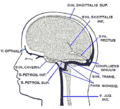Sigmoid sinus
Sigmoid sinus
The Sigmoid sinus is a dural venous sinus of the human body. It receives blood from the transverse sinuses and continues as the internal jugular vein.
Anatomy[edit]
The sigmoid sinus, also known as the pars sigmoida, is a part of the dural venous sinuses. It is a continuation of the transverse sinus and is connected to the internal jugular vein. The sinus is shaped like the Greek letter sigma (Σ), hence the name 'sigmoid'.
The sigmoid sinus begins near the mastoid foramen, travels posteriorly and inferiorly, and then turns medially to become the internal jugular vein. It is located within the dura mater, a layer of the meninges that surrounds the brain and spinal cord.
Function[edit]
The primary function of the sigmoid sinus is to drain blood from the brain. It receives blood from the transverse sinuses, which in turn receive blood from the superior sagittal sinus and inferior sagittal sinus. The sigmoid sinus then drains into the internal jugular vein, which carries deoxygenated blood away from the brain and towards the heart.
Clinical significance[edit]
The sigmoid sinus can be involved in several medical conditions. Thrombosis (clotting) in the sigmoid sinus can lead to cerebral venous sinus thrombosis, a serious condition that can cause stroke-like symptoms. The sigmoid sinus can also be affected by pulsatile tinnitus, a condition where a person hears a rhythmic pulsing sound, often in time with their heartbeat.
See also[edit]
References[edit]
<references />
| Veins of the head and neck | ||||
|---|---|---|---|---|
This veins of the head and neck related article is a stub.
|
-
Gray488 blue
Ad. Transform your life with W8MD's Budget GLP-1 injections from $75


W8MD offers a medical weight loss program to lose weight in Philadelphia. Our physician-supervised medical weight loss provides:
- Weight loss injections in NYC (generic and brand names):
- Zepbound / Mounjaro, Wegovy / Ozempic, Saxenda
- Most insurances accepted or discounted self-pay rates. We will obtain insurance prior authorizations if needed.
- Generic GLP1 weight loss injections from $75 for the starting dose.
- Also offer prescription weight loss medications including Phentermine, Qsymia, Diethylpropion, Contrave etc.
NYC weight loss doctor appointmentsNYC weight loss doctor appointments
Start your NYC weight loss journey today at our NYC medical weight loss and Philadelphia medical weight loss clinics.
- Call 718-946-5500 to lose weight in NYC or for medical weight loss in Philadelphia 215-676-2334.
- Tags:NYC medical weight loss, Philadelphia lose weight Zepbound NYC, Budget GLP1 weight loss injections, Wegovy Philadelphia, Wegovy NYC, Philadelphia medical weight loss, Brookly weight loss and Wegovy NYC
|
WikiMD's Wellness Encyclopedia |
| Let Food Be Thy Medicine Medicine Thy Food - Hippocrates |
Medical Disclaimer: WikiMD is not a substitute for professional medical advice. The information on WikiMD is provided as an information resource only, may be incorrect, outdated or misleading, and is not to be used or relied on for any diagnostic or treatment purposes. Please consult your health care provider before making any healthcare decisions or for guidance about a specific medical condition. WikiMD expressly disclaims responsibility, and shall have no liability, for any damages, loss, injury, or liability whatsoever suffered as a result of your reliance on the information contained in this site. By visiting this site you agree to the foregoing terms and conditions, which may from time to time be changed or supplemented by WikiMD. If you do not agree to the foregoing terms and conditions, you should not enter or use this site. See full disclaimer.
Credits:Most images are courtesy of Wikimedia commons, and templates, categories Wikipedia, licensed under CC BY SA or similar.
Translate this page: - East Asian
中文,
日本,
한국어,
South Asian
हिन्दी,
தமிழ்,
తెలుగు,
Urdu,
ಕನ್ನಡ,
Southeast Asian
Indonesian,
Vietnamese,
Thai,
မြန်မာဘာသာ,
বাংলা
European
español,
Deutsch,
français,
Greek,
português do Brasil,
polski,
română,
русский,
Nederlands,
norsk,
svenska,
suomi,
Italian
Middle Eastern & African
عربى,
Turkish,
Persian,
Hebrew,
Afrikaans,
isiZulu,
Kiswahili,
Other
Bulgarian,
Hungarian,
Czech,
Swedish,
മലയാളം,
मराठी,
ਪੰਜਾਬੀ,
ગુજરાતી,
Portuguese,
Ukrainian

